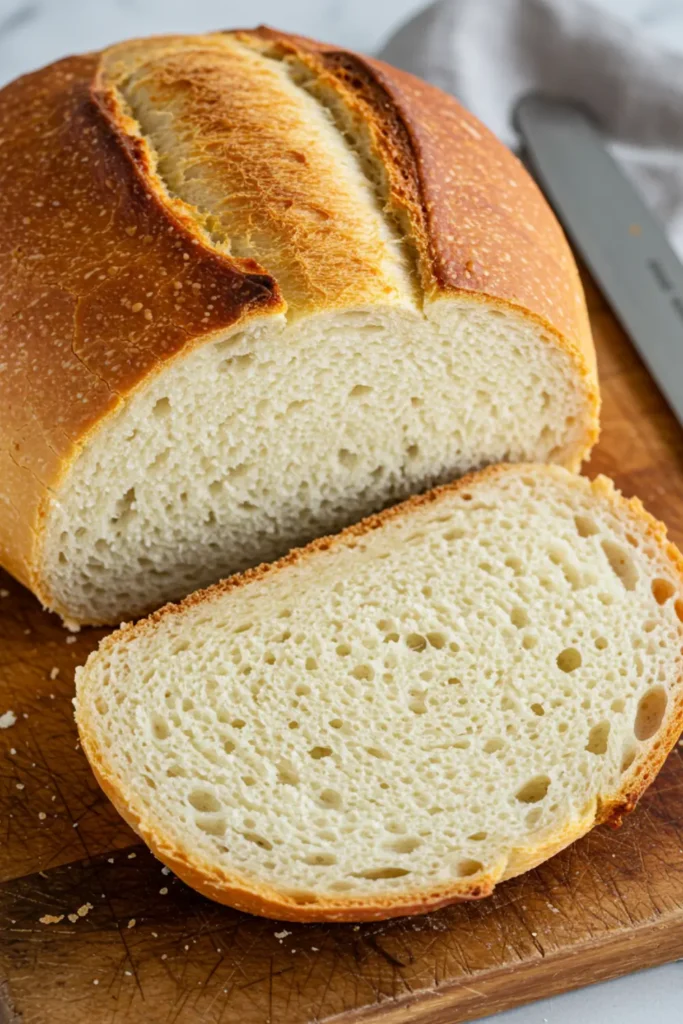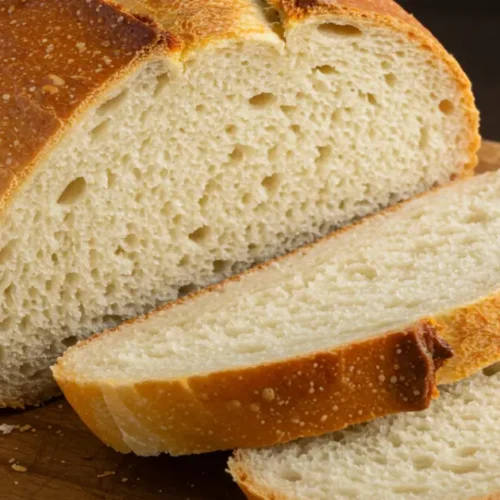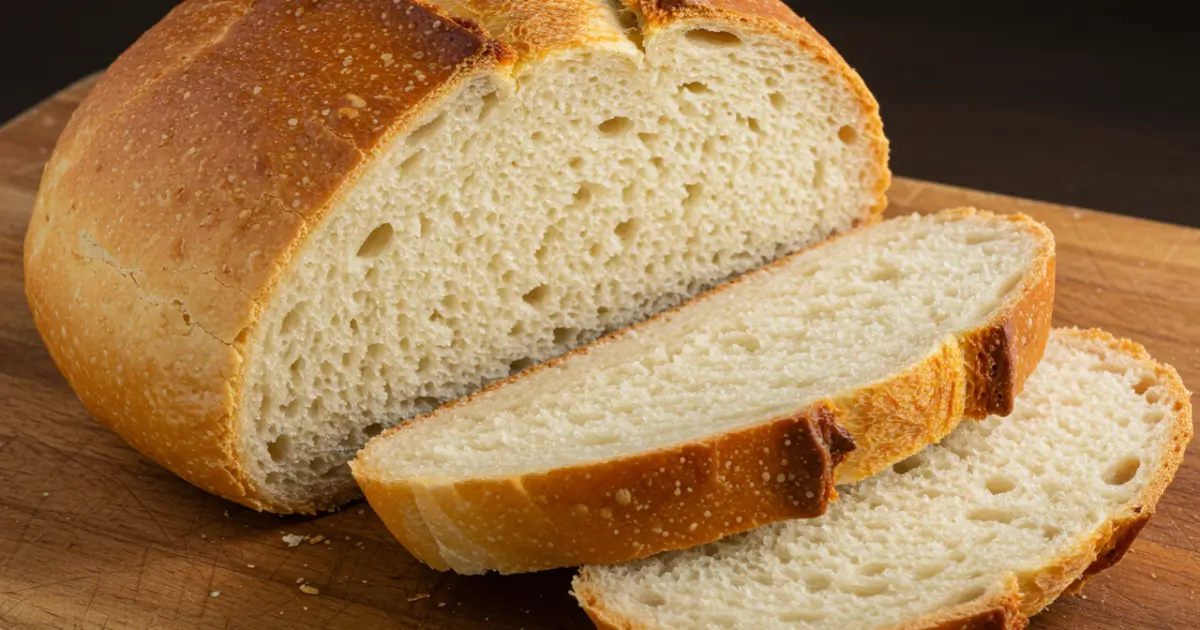You know the feeling. That quiet joy when your kitchen fills with the scent of warm, freshly baked bread. It’s not just food—it’s an experience that reconnects you with simple pleasures. When you take flour, water, yeast, and salt, then mix them with your hands and heart, you get more than a loaf. You create nourishment, comfort, and even a little bit of pride.
Why We Love This Homemade Bread Recipe
Homemade bread is more than a recipe—it’s a reminder of slower moments, real ingredients, and the joy of making something from scratch. Here’s why you’ll fall in love with this loaf:
- Freshness you can taste – No preservatives or additives
- Control over ingredients – Customize it to suit your dietary needs
- Budget-friendly – A loaf at home costs a fraction of a bakery one
- Beginner-friendly – A forgiving recipe that welcomes trial and error
- Nourishing and satisfying – Pairs with every meal or stands on its own

Ingredients
All-purpose flour – I recommend using unbleached, high-protein all-purpose flour for better gluten development. If you choose a lower-protein flour, your bread may lack the desired texture and rise.
Active dry yeast – Active dry yeast is essential for helping the dough rise. Avoid substituting with instant yeast unless you’re adjusting the recipe’s rising times.
Sugar – Sugar helps activate the yeast and adds a slight sweetness. If you prefer, you can substitute with honey or organic sugar, though it may alter the flavor slightly.
Vegetable oil or melted butter – Either of these adds moisture and richness to the bread. If you prefer a dairy-free option, vegetable oil is a great choice.
How to Make Homemade Bread (Step-by-Step Guide)
Activate the yeast: In a large bowl, combine warm water, sugar, and yeast. Let it sit for 5 to 10 minutes. You should see bubbles and foam forming—a sign your yeast is active.
Mix the dough: Add the flour, salt, and oil. Stir with a wooden spoon until a shaggy dough forms.
Knead: Transfer the dough to a floured surface. Knead it for 8 to 10 minutes until it feels smooth and elastic.
First rise: Place the dough in a lightly greased bowl, cover with a clean towel, and let it rise in a warm spot for 1 hour or until doubled in size.
Shape the loaf: Punch down the dough gently. Shape it into a loaf and place it in a greased bread pan.
Second rise: Cover the loaf with a towel and let it rise again for 30 to 45 minutes.
Bake: Preheat your oven to 375°F (190°C). Bake for 30 to 35 minutes, or until the top is golden brown and it sounds hollow when tapped.
Cool: Remove from the pan and place on a wire rack. Let it cool for at least 15 minutes before slicing.
Expert Tips for Perfect Homemade Bread
Weigh your ingredients: Accuracy is key, especially with flour
Knead with intention: Don’t rush the kneading—it builds the gluten structure
Don’t skip the second rise: It adds volume and a better texture
Create steam: Place a shallow tray of water in the oven to boost crustiness
Use a thermometer: Internal bread temperature should hit 190°F for doneness
Delicious Variations to Try
Make It Your Own with These Bread Variations
Whole Wheat Bread: Swap half of the white flour for whole wheat
Herbed Bread: Add chopped rosemary, thyme, or oregano into the dough
Cheesy Loaf: Fold in shredded cheddar or mozzarella for a gooey twist
Seeded Top: Sprinkle sesame, sunflower, or poppy seeds before baking
Sweet Cinnamon Bread: Add a cinnamon sugar swirl for a breakfast treat
Serving Suggestions
How to Enjoy Your Homemade Bread
- Warm with a pat of butter and local honey
- Sliced thick for grilled cheese or sandwiches
- Toasted and topped with mashed avocado and chili flakes
- Cubed for homemade croutons or breadcrumbs
- Served with soups or stews for hearty dipping
More Bread recipes you will love!
Frequently Asked Questions About Homemade Bread
How long does homemade bread stay fresh?
Homemade bread stays fresh at room temperature for about 2 to 3 days if stored in an airtight container. For longer storage, freeze slices and toast as needed.
Why did my bread turn out dense?
Dense loaves usually result from not kneading long enough or letting the dough rise in a cold spot. Check yeast freshness and ensure your water isn’t too hot or too cold.
Can I make homemade bread without a stand mixer?
Absolutely. This recipe was designed to be mixed and kneaded by hand. It just takes a little more effort, but the results are just as rewarding.
Is homemade bread healthier than store-bought bread?
Yes, because you control the ingredients. There are no preservatives, additives, or hidden sugars in your homemade loaf.
What type of flour is best for baking bread?
All-purpose flour works well for this recipe, but if you prefer a chewier texture and taller rise, use bread flour. It has a higher protein content that supports better gluten development.

Homemade Bread
Equipment
- Oven
- Bread Pan
Ingredients
- 3 ½ cups All-purpose flour
- 1 ¼ cups Warm water around 110°F
- 2 ¼ teaspoons Active dry yeast 1 standard packet
- 1 tablespoon Sugar
- 1 ½ teaspoons Salt
- 1 tablespoon Vegetable oil or melted butter
Instructions
- Combine warm water, sugar, and yeast in a bowl. Let sit for 5 to 10 minutes until bubbles form.
- Mix in the flour, salt, and oil. Stir until a shaggy dough forms.
- Knead the dough for 8 to 10 minutes until smooth and elastic.
- Place dough in a greased bowl, cover, and let rise for 1 hour until doubled in size.
- Punch down dough, shape into a loaf, and place in a greased bread pan. Let rise for 30 to 45 minutes.
- Preheat oven to 375°F (190°C). Bake for 30 to 35 minutes or until golden brown and hollow when tapped.
- Cool on a wire rack for at least 15 minutes before slicing.
Send me this recipe!
Just enter your email below and get it sent straight to your inbox!


